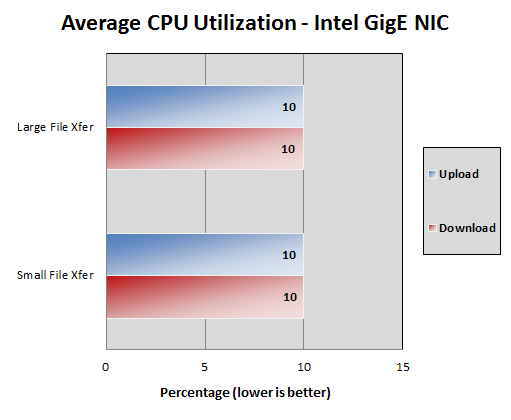Board Port Device Testing
ATTO Disk Benchmark
To validate that the board’s device ports were functioning correctly, we connected an OCZ Vertex 3 90GB SATA III SSD to the system and ran the ATTO Disk Benchmark against the drive. ATTO was configured to test against transfer sizes from 0.5 to 8192 KB with Total Length set to 512 MB. The SSD selected for testing has a maximum read throughput of 550 MB/s and a write throughput of 500 MB/s on a SATA III port and a maximum read throughput of 280 MB/s and a write throughput of 260 MB/s on a SATA II port .
External device testing was done against the USB 2.0, USB 3.0, and eSATA ports using conversion cables to connect the SSD. The SSD was connected to the internal SATA II and SATA III ports as well. The SATA device ports were set to work in AHCI mode in order to optimize SSD device operation. All tests were run 3 times with the highest repeatable read and write scores recorded in MB/s values.
According to various other testing sites, the real-world performance maximum of USB 2.0 peaks at 35-40MB/s (about 60% of its rated 60MB/s throughput, USB 3.0 peaks at 200-250MB/s (about 60-75% of its rated 350MB/s throughput), and eSATA peaks at about 400-450MB/s (about 60-75% of its rated 700MB/s throughput). The external performance numbers speak for themselves with all device ports performing very close to their respective real-world maximum throughput numbers.
The biggest surprise here was the performance of the ASMedia USB 3.0 controller. Normally, the chipset integrated device controllers have a performance advantage over the board mounted controllers, but the ASMedia USB 3.0 controller was able to outperform the Intel Z77 controller in read performance and almost match it in write performance.
No unexpected surprises in the internal device port tests. The Intel Z77-based SATA ports saw read and write performance maxing out the SSD device specifications in both SATA II and SATA III device configurations. The Marvell controlled port showed promise with its read performance, but showed sub-par write performance with it falling below even that of the Intel-based SATA II ports.
SoftPerfect Research NetWorx Speed Test
In conjunction with Windows Task Manager, SoftPerfect Research NetWorx Speed Meter application was used to measure the upload and download performance of the motherboards integrated network controllers. In testing, both Intel GigE NIC ports were found to operate similarly, so only one set of numbers was reported on. Speed Meter was used to measure average network throughput in MB/s with Windows Task Manager used to measure CPU utilization during the tests.
The testing consisted of copying two file sets from and to a remote system directly connected to the local system via a crossover cable. Use of a crossover cable eliminates the possibility of throughput loss due to router passage. The two file sets used consisted of a single 750 MB archive file and a folder containing 750 MB of audio files.
Intel GigE controller
The Intel GigE network controllers performed well within expectations with the large file results beating out those of the small file results. For both file sets, download speeds exceeded upload by 20 MB/s or greater with the best performance seen during the large file download testing. In respect to the theoretical maximum throughput of gigabit Ethernet ports of 125 MB/s, both the small file download average of 72 MB/s and the large file average of 87 MB/s are praiseworthy. In all cases, the average CPU utilization remained at or under 10%.












In looking at the components
In looking at the components on the board and comparing it to other gaming ones, most of the components are the same (just wish I could see which VRM’s it was using)
I am not seeing where all of those additional cost are coming from.
Some of the additional costs
Some of the additional costs come from the dual Intel-based NICs. Not only are they true Intel GigE NICS, but the NICs themselves are the L-series that are server-class adapters.
Most manufacturers only include a single Intel NIC (when doing dual-NIC config) or pass on Intel NICs entirely for the cheaper Realtek or Marvell based NICs.
Go4 thunderbolt motherboard,
Go4 thunderbolt motherboard, think about the future.
Buy an addon card.. ..think
Buy an addon card.. ..think about the present
Great post. I have read this
Great post. I have read this article. This article is really informative. I will be grateful if you continue this in future. Many people will be benefited from your writing.
http://www.durontotech.com/intel-desktop-board-dx79sr-overview/